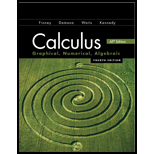
Concept explainers
a.
Tofindthe interval on which the function
a.
Answer to Problem 4RE
The function is then increasing for
Explanation of Solution
Given information:
The given function is
Formula:
Chain rule:
Consider the function
Using product and chain rule:
Here
Now setting the derivative equal to zero to find the critical values,
Therefore, the critical values are
From the critical values the possible intervals are
Now to determine which of the intervals is increasing,
Consider
Consider
Consider
Therefore, the function is increasing for
b.
To find the interval on which the function
b.
Answer to Problem 4RE
The function is then decreasing for
Explanation of Solution
Given information:
The given function is
Formula:
Chain rule:
Consider the function
Using product and chain rule:
Here
Now setting the derivative equal to zero to find the critical values,
Therefore, the critical values are
From the critical values the possible intervals are
Now to determine which of the intervals is decreasing,
Consider
Consider
Consider
Therefore, the function is decreasing for
c.
To find the interval on which the function
c.
Answer to Problem 4RE
The function is concave up for
Explanation of Solution
Given information:
The given function is
Formula:
Chain rule:
Consider the function
Using product and chain rule:
Find second derivative,
The function is undefined whenever the denominator is equal to zero.
Therefore, the inflection points are at
Inflection point at
is not in the domain of the function.
Consider
Consider
Therefore, the function is concave up from
d.
To find the interval on which the function
d.
Answer to Problem 4RE
The function is concave down for
Explanation of Solution
Given information:
The given function is
Formula:
Chain rule:
Consider the function
Using product and chain rule:
Find second derivative,
The function is undefined whenever the denominator is equal to zero.
Therefore, the inflection points are at
Inflection point at
is not in the domain of the function.
Consider
Consider
Therefore, the function is concave down from
e.
To find the interval on which the function
e.
Answer to Problem 4RE
The function haslocal maximum values at
Explanation of Solution
Given information:
The given function is
Formula:
Chain rule:
Consider the function
Using product and chain rule:
Here
Now setting the derivative equal to zero to find the critical values,
The domain of
Consider
Consider
Consider
Since
Since
Therefore, the function has local maximum values at
f.
To find the interval on which the function
f.
Answer to Problem 4RE
The function hasinflection point at
Explanation of Solution
Given information:
The given function is
Formula:
Chain rule:
Consider the function
Using product and chain rule: 6
Find second derivative,
The sign of
When
When
When
Now to determine the sign of
Therefore, the function has inflection point at
Chapter 5 Solutions
Calculus 2012 Student Edition (by Finney/Demana/Waits/Kennedy)
Additional Math Textbook Solutions
College Algebra (7th Edition)
Algebra and Trigonometry (6th Edition)
A Problem Solving Approach To Mathematics For Elementary School Teachers (13th Edition)
Introductory Statistics
Calculus: Early Transcendentals (2nd Edition)
- a -> f(x) = f(x) = [x] show that whether f is continuous function or not(by using theorem) Muslim_mathsarrow_forwardUse Green's Theorem to evaluate F. dr, where F = (√+4y, 2x + √√) and C consists of the arc of the curve y = 4x - x² from (0,0) to (4,0) and the line segment from (4,0) to (0,0).arrow_forwardEvaluate F. dr where F(x, y, z) = (2yz cos(xyz), 2xzcos(xyz), 2xy cos(xyz)) and C is the line π 1 1 segment starting at the point (8, ' and ending at the point (3, 2 3'6arrow_forward
- I need help in ensuring that I explain it propleryy in the simplifest way as possiblearrow_forwardI need help making sure that I explain this part accutartly.arrow_forwardPlease help me with this question as I want to know how can I perform the partial fraction decompostion on this alebgric equation to find the time-domain of y(t)arrow_forward
- Please help me with this question as I want to know how can I perform the partial fraction on this alebgric equation to find the time-domain of y(t)arrow_forwardEvaluate F³ - dr where ♬ = (4z, -4y, x), and C' is given by (t) = (sin(t), t, cos(t)), 0≤t≤ñ .arrow_forwardMid-Term Review Find the formula for (f + g)(x). f(x) = x² - 10x + 25 and g(x) = x² - 10x + 24 (f + g) (x) = [ 2 ]x² X + DELL Skip Sarrow_forward
 Calculus: Early TranscendentalsCalculusISBN:9781285741550Author:James StewartPublisher:Cengage Learning
Calculus: Early TranscendentalsCalculusISBN:9781285741550Author:James StewartPublisher:Cengage Learning Thomas' Calculus (14th Edition)CalculusISBN:9780134438986Author:Joel R. Hass, Christopher E. Heil, Maurice D. WeirPublisher:PEARSON
Thomas' Calculus (14th Edition)CalculusISBN:9780134438986Author:Joel R. Hass, Christopher E. Heil, Maurice D. WeirPublisher:PEARSON Calculus: Early Transcendentals (3rd Edition)CalculusISBN:9780134763644Author:William L. Briggs, Lyle Cochran, Bernard Gillett, Eric SchulzPublisher:PEARSON
Calculus: Early Transcendentals (3rd Edition)CalculusISBN:9780134763644Author:William L. Briggs, Lyle Cochran, Bernard Gillett, Eric SchulzPublisher:PEARSON Calculus: Early TranscendentalsCalculusISBN:9781319050740Author:Jon Rogawski, Colin Adams, Robert FranzosaPublisher:W. H. Freeman
Calculus: Early TranscendentalsCalculusISBN:9781319050740Author:Jon Rogawski, Colin Adams, Robert FranzosaPublisher:W. H. Freeman
 Calculus: Early Transcendental FunctionsCalculusISBN:9781337552516Author:Ron Larson, Bruce H. EdwardsPublisher:Cengage Learning
Calculus: Early Transcendental FunctionsCalculusISBN:9781337552516Author:Ron Larson, Bruce H. EdwardsPublisher:Cengage Learning





